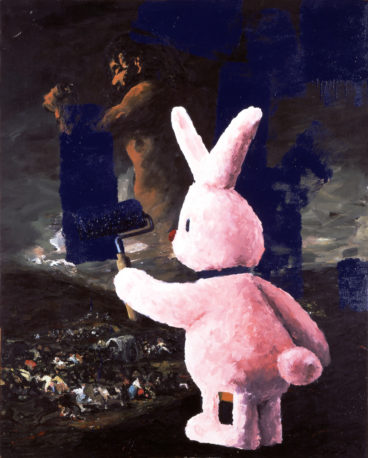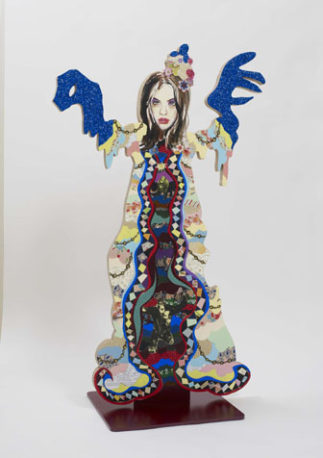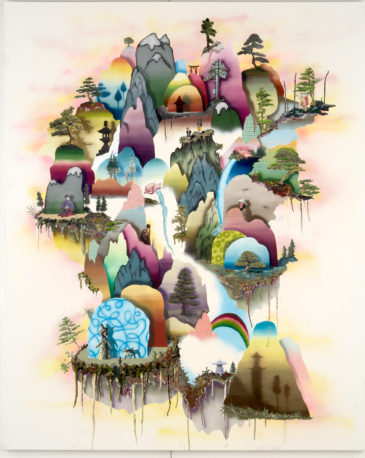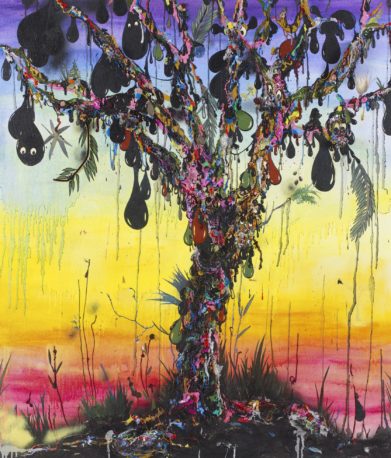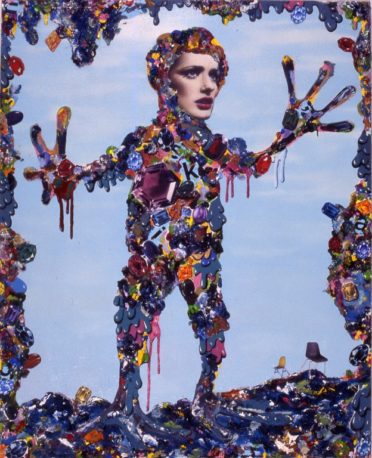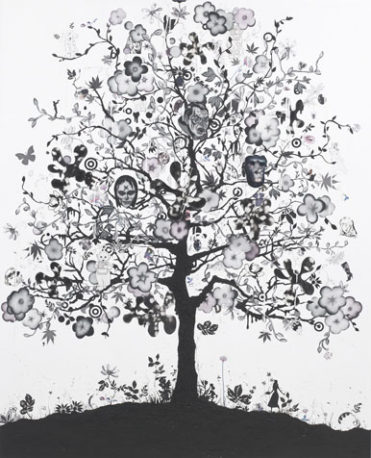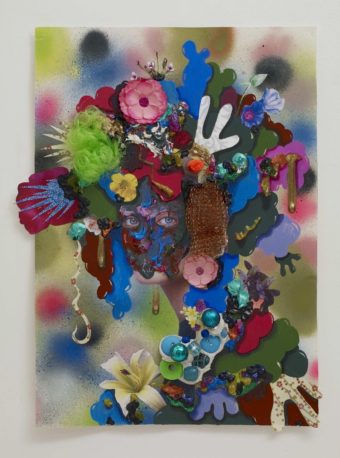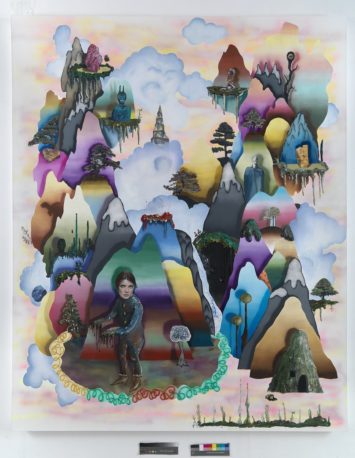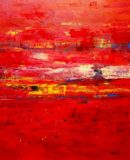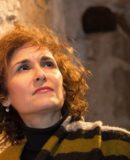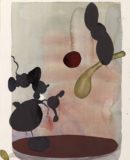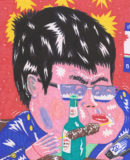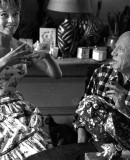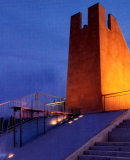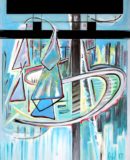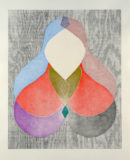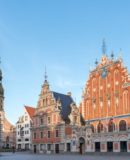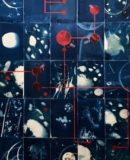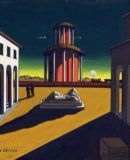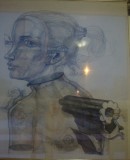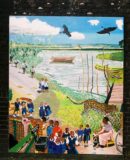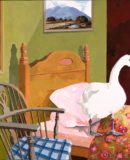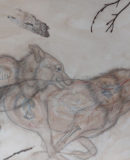World Fine Art Professionals and their Key-Pieces, 109 - Alicia Paz
World Fine Art Professionals and their Key-Pieces, 109 – Alicia Paz
Identity has many layers and is fluid. The work of Alicia Paz exemplifies this. A multi-cultural artist born in Mexico and now based in London, she has also spent substantial periods of time in France and in the USA.
Living in the UK is interesting to Paz, in so far as it is a country that is constantly redefining its identity as a nation and its relation to the world, now as much as ever. Besides her painting practice, Paz also teaches at UAL Wimbledon College of Arts in London. She is a graduate of UC Berkeley, the Ecole des Beaux-Arts of Paris and also Royal College of Art, London.
A female subjectivity
Not only the diversity of her origins and experiences has given shape to the elaboration of the theme identity, but also being a woman plays a role. Paz states: “I focus on female figures, because the female subject-position is one that can encompass more freely the fluidity of multiple identities, incorporating otherness in various ways. In many cultures, women change their surname to reflect their civil status/life situations. Through the possibility of pregnancy, they can potentially be more than one person.” Paz also reflects on a hybrid psychological identity as generated through complex family histories.
Alicia Paz has built up a considerable body of work. She has categorized it in a number of topics: Painting Allegories, Standing Figures, Trees, Masked Characters/Female Figures, Mountains and Towers, as well as Monsters and Artists. Asked for a key work, Paz points out several.
Colossus
In the first category, Painting Allegories, she mentions ‘Colossus’ (1995). You see hurrying wagons and horses and, transcending above it all, the colossal giant of the eponymous painting by Goya. But in front there is now a Duracell rabbit, painting on the original image with strokes of blue paint, using an industrial roller. “I made the painting in New York. I had won an award in Paris that enabled me to travel. I spent three months at CUNY in NYC in the autumn 1995. During this time I worked on reinventing themes that are dear to the XVIII century, namely, that of the “monkey painter” and other parodies of the “artist” figure, in which the futile vanity of the artist figure is examined. I used this as a conceptual kind of framework to reflect on the notion of a divided author and the enormous baggage of painting’s history.”
“I was looking for ways to juxtapose elements of popular culture and high art. The Ecole des Beaux-arts in Paris was surrounded by museums, the Louvre among others. There was a respectful attitude to art. Works on pedestals, artists painting behind their easels. But in academic circles there was a quest for something new. I considered different kinds of painting. I chose an automaton, a toy rabbit, painting on a classical work with Yves Klein blue. It is a representation of the artist and the act of painting. It is not only painting, but also destruction, but this is also part of the creative process. The rabbit is destroying the Goya. The painter is merging with the paint. It’s the history of painting in one work.”
In the same allegorical series, there is the work ‘Marie Madelene Guimard’ (1997), where there is also an act of iconoclasm going on. “The original is made by Jean-Honoré Fragonard (1770). It hangs in the Louvre. I painted a white frame as part of the painting, so it resembles a reproduction, a postcard.” The original was in oil, Paz’s version is in acrylic. “You can interpret this in various ways, one of them through the lens of post-modernist appropriation, for example. The British artist Malcolm Morley once spoke of using an existing image of an artwork as source material to create a new painting, in a similar way to how a musician uses a partition to interpret a musical piece.”
Trees talk and sing
In the next category, Standing Figures, there is ‘Madama Butterfly’ (2013). It has two sides or versions, one with blue hands, one with black hands. All figures in this series have a front and a back. Paz has a penchant for doubles /copies, and silhouettes have much to do with this. In the Rococo period, around 1740, the silhouette was popular, as part of an exploration of artifice and theatricality, of shadow play and costume drama. In her series of Standing Figures, Paz portrays the artist figure in a performative sense, as opera singers, clowns, dancers and acrobats. Ancient Greeks considered silhouettes as the very origin of painting. It is a way for Paz to bridge the gap between painting and sculpture.
We go to the Trees series. Paz pictures them in anthropomorphous fashion; her trees talk and sing. “Their oracular quality stems from a chattering, tree-dwelling community of parrots, neurotic women, mysterious green men, butterflies, and an assortment of ghosts. Ambiguous narratives and tongue-in-cheek fairy-tales play hide-and-seek among the branches”. There is a black and white tree, titled ‘Chiaro-Oscuro’. If you look closely, you’ll encounter terrifying figures, but also some very benign ones. This lace-like painting is about juggling opposites and cycles of life and death. You see a multiplicity of characters in Paz’s trees, monkeys and also skulls, for instance, which refer to the Dutch painting tradition of Vanitas.
Alicia Paz likes the idea of botanical grafting and applies the notion, pictorially, in some of the tree paintings. “They are elements which are like parasites on trees, little plants growing on something larger”. Trees allow for an exploration of multiple painting styles, like a panoply of pictorial languages all branching out, and which can be unified by a single trunk. Paz grew up in Northern Mexico, near the US border, the Rio Grande. In London, she lives south of the river Thames. In her works ‘South of the River’ (2007) and ‘Blob Dawn’ (2009) you see trees dripping, as if emerging from an oily swamp. Then there is ‘Weeping Medusa’ (2008) . “It is like a monster tree, a weeping willow. The figure in the tree is weeping paint, pigment.”
A multitude of balconies
We continue with the Masked Characters/Female Figures. These are textured assemblages and paper collages, of varying formats. In ‘Run Deep’ (2013) you see a female figure amidst seaweed. Details allow for an interweaving of many stories, paintings inside the painting. The viewer can discover strange and mysterious sea creatures, and the central female character is flowing in the water, her hair has become a tangle of tentacles. In ‘Brillo Head‘ one can see a photographic portrait covered in an ornamental-yet-grotesque mixture of thick paint, paper, and artificial flowers. Paz is interested in the raw edge between photography and paint.
In Mountains and Towers we look at ‘Chinoiserie’ (2007) and ‘The Hills are Alive’ (2006). These are imaginary places, mental meanderings. You see small theatrical stages that repeat across the surface of the canvas, like so many front-facing balconies. Most of Paz’s paintings are kind of stage-like, have a marked frontality. Paz is also interested in the European tradition of chinoiserie, as Europe’s fantasy of another world. But ultimately, this has more to do with fancy dress, the West attempting a playful self-reinvention.
A new day
We arrive at the last category, Monsters and Artists. Here there is a reference to sci-fi, camp horror films, and surrealism. In ‘Dawn’ (2005) we see a body, covered in paint, rising from of a bog of detritus. The title refers to both the time of day and to the woman’s name. One can see mud, but in the midst of the quagmire, one also finds precious stones, like forgotten treasures. The woman’s face is dramatic, beautiful, but her body is monstrous, amphibian-like. It is difficult to say if it is morning or evening, in any case, all of the figures in this series exist in a kind of twilight zone. They are an amalgam of 3 archetypes: woman, monster, and artist. They are morphing, merging with the organic materiality of paint and a deluge of post-cognitive imagery, always in flux.
inally: what is Alicia’s philosophy? “Art is a process, an artist is always moving. It is a combination of process and Imagination”.
Images: 1) Colossus, 1995, Acrylic on canvas, Municipal Collection of the City of Paris, 2) Madama Butterfly, 2013, mixed media on plywood, 3) Run Deep, 2013, mixed media on board, 4) When the Machine stops, mixed media on canvas, Colecion Constantine, 5) Chinoiserie, 2007, oil, acrylic, collage on canvas, 6) South of the River, mixed media on canvas, 7) Black Dawn, 8) Dawn, 9) Chiaro Oscuro, 2006, oil, acrylic, collage on canvas, 10) Brillo Head, 11) The Hills are Alive.
http://www.aliciapaz.co.uk/
http://www.galeriedukan.com/
http://ifthenisnow.eu/nl/node/178496
Disclaimer: The views, opinions and positions expressed within this guest article are those of the author Walter van Teeffelen alone and do not represent those of the Marbella Marbella website. The accuracy, completeness and validity of any statements made within this article are not guaranteed. We accept no liability for any errors, omissions or representations. The copyright of this content belongs to Walter van Teeffelen and any liability with regards to infringement of intellectual property rights remains with the author.

